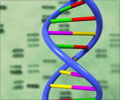Only about two percent of a person's genome is eventually converted into proteins, given the long way from DNA to RNA to protein.

Research led by Ed Morrisey, PhD, professor of Medicine and Cell and Developmental Biology in the Perelman School of Medicine, University of Pennsylvania and scientific director of the Penn Institute for Regenerative Medicine, has identified hundreds of these lncRNAs, sometimes called the "genomic dark matter," that are expressed in developing and adult lungs. Their findings, described in and featured on the cover of the current issue of Genes and Development, reveal that many of these lncRNAs in the lung regulate gene expression by opening and closing the DNA scaffolding on neighboring genes.
The team identified 363 long non-coding RNAs in the lung of the embryonic and adult mouse. They show that these lncRNAs are often located near transcription factors in the genome of lung cell lineages. "We have defined a new association of long non-coding RNAs with proteins called transcription factors that bind to specific DNA sequences and control cell identity and function," Morrisey says. "This association is important for lung development in mouse embryos, and at least for one of these long non-coding RNAs, important for human lung function."
Critical Pathways for Development, Disease
The team identified a lncRNA, called NANCI, that regulates the critical transcription factor Nkx2.1. This factor is the first lung molecular marker during mouse and human development and is essential for lungs to mature properly in an embryo.
NANCI appears to act upstream of Nkx2.1, but down-stream of Wnt signaling, a critical pathway for specifying cell type later in lung tissue development. Knockdown of NANCI expression during lung development leads to decreased Nkx2.1 expression and mimics the defects due to loss of a single copy of the Nkx2.1 gene, including decreased expression of surfactant proteins. These proteins aid in marking bacteria invading the lung for destruction by the immune system.
Importantly, patients with mutations in a single copy of NKX2.1 often have Brain-Lung-Thyroid Syndrome, which is characterized by respiratory distress after birth and accompanied by decreased surfactant protein expression. "There is also a report of a patient with a deletion in NANCI but not NKX2.1 who has Brain-Lung-Thyroid Syndrome, suggesting that mutations in NANCI and other lncRNAs can underlie human diseases," explains Morrisey.
Advertisement
While other lncRNAs expressed in the lung, such as MALAT1, may primarily play a role in cancer progression, the data generated by the Morrisey lab provides unique insight into lncRNAs that regulate lung development. "We are hopeful that these new data provide the foundation for a better understanding of how the non-coding transcriptome regulates tissue development and also maintenance of adult tissues," says Morrisey.
Advertisement
Additional coauthors are Michael J. Herriges, Michael P. Morley, Komal S. Rathi, Tien Peng, and Kathleen M. Stewart, all from Penn and Daniel T. Swarr, from The Children's Hospital of Philadelphia.
Studies in the Morrisey lab were supported by funding from the National Heart, Lung and Blood Institute (HL100405, HL110942).
Penn Medicine is one of the world's leading academic medical centers, dedicated to the related missions of medical education, biomedical research, and excellence in patient care. Penn Medicine consists of the Raymond and Ruth Perelman School of Medicine at the University of Pennsylvania (founded in 1765 as the nation's first medical school) and the University of Pennsylvania Health System, which together form a $4.3 billion enterprise.
The Perelman School of Medicine has been ranked among the top five medical schools in the United States for the past 17 years, according to U.S. News & World Report's survey of research-oriented medical schools. The School is consistently among the nation's top recipients of funding from the National Institutes of Health, with $392 million awarded in the 2013 fiscal year.
The University of Pennsylvania Health System's patient care facilities include: The Hospital of the University of Pennsylvania -- recognized as one of the nation's top "Honor Roll" hospitals by U.S. News & World Report; Penn Presbyterian Medical Center; Chester County Hospital; Penn Wissahickon Hospice; and Pennsylvania Hospital -- the nation's first hospital, founded in 1751. Additional affiliated inpatient care facilities and services throughout the Philadelphia region include Chestnut Hill Hospital and Good Shepherd Penn Partners, a partnership between Good Shepherd Rehabilitation Network and Penn Medicine.
Penn Medicine is committed to improving lives and health through a variety of community-based programs and activities. In fiscal year 2013, Penn Medicine provided $814 million to benefit our community.
Source-Newswise









